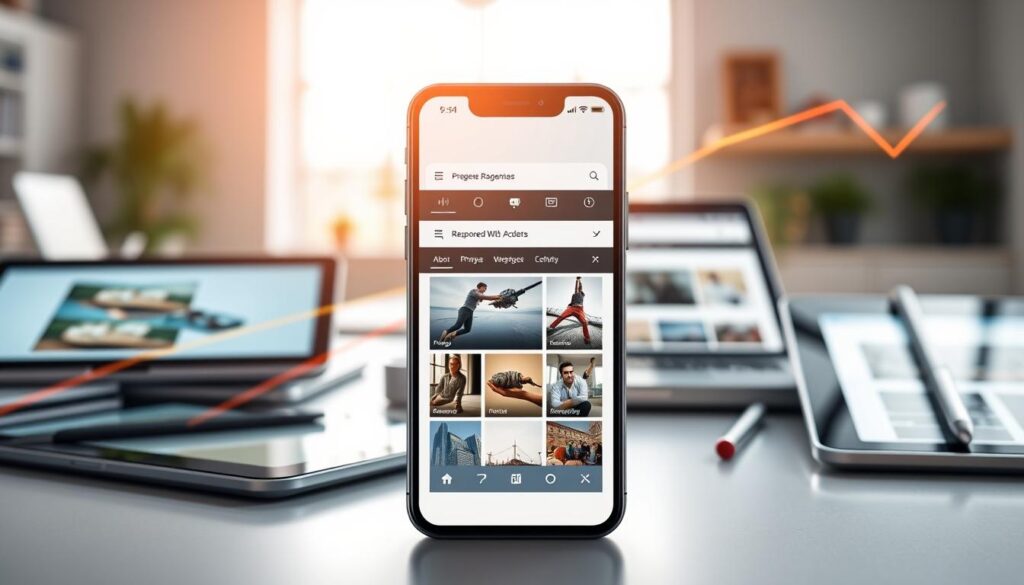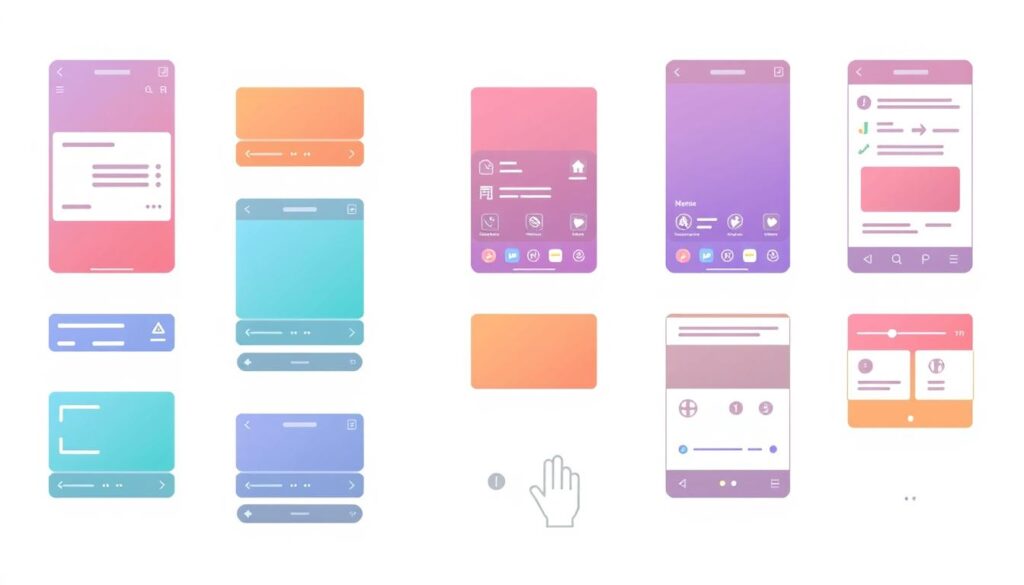The digital world is changing fast, and mobile-friendly websites are key. Over 60% of internet traffic comes from mobiles now. Businesses must make their websites work well on mobiles.
By 2025, we’ll have 7.49 billion mobile devices. This means we need websites that are easy to use on mobiles. They should be smooth, responsive, and focused on the user.
Mobile-first design has changed how we use digital content. Smartphone users want quick, easy access to what they need. They prefer content that’s short and to the point, perfect for small screens.
Search engines like Google now favor mobile-friendly websites. They use mobile-first indexing, which means mobile sites get priority. This shows how important it is to have a website that works well on mobiles for better rankings.
Key Takeaways
- Over 60% of internet traffic comes from mobile devices, making mobile-friendly websites essential.
- The number of mobile devices is projected to reach 7.49 billion by 2025, a significant increase from 2020.
- Mobile-first design prioritizes key elements like clear navigation, fast load times, and concise content.
- Responsive design, image optimization, simplified navigation, and performance optimization are crucial for creating mobile-friendly websites.
- Search engines, like Google, prioritize mobile-friendly websites in their rankings, underscoring the importance of mobile optimization.
Understanding Mobile-First Design Evolution
The way we use mobile devices has changed a lot in recent years. Today, 57% of all internet traffic worldwide in 2023 comes from mobile sources (Statista). This big change has made businesses rethink how they design websites, leading to mobile-first design.
Current Mobile Usage Statistics
The global smartphone market is growing fast. It’s expected to grow by a 7.3% CAGR from $484.81 billion in 2022 to $792.51 billion in 2029 (Fortune Business Insights). Also, about 56% of all sales are made via smartphones, and over 50% of all web traffic comes from mobile devices (Statista).
Impact on User Behavior
Mobile devices have changed how we act online. Google’s algorithm now favors mobile-friendly websites, making them easier to find. Also, mobile-first design can make websites less likely to be left quickly, as mobile-friendly sites have lower bounce rates.
Future Projections for 2025
In the future, mobile’s role in our digital lives will only get bigger. Mobile devices are expected to reach 18.22 billion worldwide by 2025. This shows how crucial mobile-first design is for businesses to connect with their audience.

“Over half of all web traffic comes from mobile devices, indicating the critical importance of mobile-first design for engaging modern audiences effectively.”
Mobile-Friendly Websites: Core Components
The world is moving fast, and websites need to keep up. Mobile Optimization and Cross-Device Compatibility are key for a smooth user experience. They ensure websites work well on all devices.
Responsive design is at the heart of mobile-friendly sites. It makes sure the site looks good on any screen size. This is done with flexible grids and smart CSS media queries.
| Feature | Importance |
|---|---|
| Responsive Design | Adapts website layout to various screen sizes and resolutions for optimal viewing and interaction on any device. |
| Optimized Images and Media | Reduces load times and improves performance on mobile devices, enhancing the overall user experience. |
| Simplified Navigation | Provides a clear and intuitive mobile experience, with features like collapsible menus and priority link placement. |
| Performance Optimization | Ensures fast load times and smooth performance, critical for users on the go who expect instant access to content. |
Mobile-first design puts the focus on what’s most important. This means clear navigation, quick loading, and simple content. It makes sure the mobile experience is the main priority.
By focusing on these key areas, websites can offer great mobile experiences. It’s important to include Mobile Optimization and Cross-Device Compatibility in the design and development. This keeps websites relevant and meets the changing needs of users.

“The future of the web is mobile, and Google’s algorithms have been designed to reflect this reality.”
Responsive Design Implementation Strategies
Making a website work well on mobiles needs a smart plan. Designers use flexible grids, CSS media queries, and the right viewport settings. This makes sure the site looks good on many devices.
Flexible Grid Layouts
Responsive design starts with flexible grids, thanks to CSS Grid or Flexbox. These systems let content change and move as the screen size changes. This makes the site look neat and nice on any device.
Designers play with different grid setups and sizes. They find the right mix for a smooth, responsive look.
CSS Media Queries
Media queries are key for responsive design. They let developers add special CSS styles for different devices. This way, sites change smoothly between layouts, making them easy to read and use on Responsive Design and Mobile-Friendly Websites.
Viewport Configurations
Getting the viewport right is crucial for how a site looks on various devices. The right <meta name="viewport"> tag in the HTML head helps. It tells the browser how to scale and size the content for the screen.
This stops problems like tiny text or content that goes off the page.
Design tools like Figma or Sketch help a lot with responsive design. They let designers see how the site looks on different devices. Browser developer tools also help check how a site works on different screens. This lets developers tweak the Responsive Design and Mobile-Friendly Websites for the best user experience.

“Implementing responsive design ensures the website looks polished on any device, from a 4-inch phone to a 14-inch laptop.”
Optimizing Images and Media Content
In today’s mobile-first world, making images and media fast is key for a great Mobile User Experience. Big images can slow down websites, making users unhappy and leaving. To make your Mobile Optimization work, you need to find the right balance between image quality and size.
Compressing images with tools like TinyPNG or ImageOptim is a simple fix. These tools make images smaller without losing quality. Also, using or srcset lets you show the right image size for each device.
Using new image formats like WebP is another smart move. WebP images are smaller than JPEG and PNG, making websites load faster. This means your mobile site will be quick and fun to use.
| Image Format | Best Use Case | Compression Ratio |
|---|---|---|
| JPEG | Complex color photographs | Excellent |
| PNG | Flat illustrations, logos, icons with transparency | Good |
| WebP | General-purpose images | Superior |
| GIF | Limited color images, animations | Fair |
By using these tips, your mobile site will look great and work fast. This will make your users happy and keep them coming back.

Mobile Navigation Best Practices
Creating a user-friendly mobile navigation is key for a great Mobile User Experience on Mobile-Friendly Websites. It involves several important elements. These elements work together to make your site or app easy to use and find what you need.
Hamburger Menu Implementation
The hamburger menu, with its three lines, is a common sight in mobile design today. It lets users tap to open a menu with all options, keeping the screen clean and simple.
Touch-Friendly Interface Elements
Navigation elements like buttons and links should be big enough (at least 48px by 48px) and well-spaced. This makes it easier to tap without mistakes, improving the Mobile User Experience.
Priority Link Placement
On mobile, show the most important links first and make them easy to find. This helps create a clear path for users to find what they need quickly.
Following these best practices can make your Mobile-Friendly Website easy to use and enjoyable for visitors. It keeps them interested and engaged.

| Navigation Pattern | Suitability | Usability Considerations |
|---|---|---|
| Top Navigation Bar | Fewer than 5 navigation options | Easy to access, but limited space |
| Tab Bars and Navigation Bars | Fewer than 5 navigation options | Intuitive and visually clear, but limited options |
| Hamburger Menus | Large number of navigation options | Compact, but users may forget to open the menu |
| Navigation Menus | Content-heavy websites | Comprehensive, but less discoverable |
| Navigation Hub | Task-based websites and apps | Organized and focused, but may require additional steps |
Performance Optimization Techniques
In today’s fast-paced world, making your website fast is key. With more people using mobiles than desktops, how quickly your site loads matters a lot. It can make or break your online success.
To make your mobile-friendly site run better, try these tips:
- Use tools like Terser to shrink your CSS, JavaScript, and HTML. This makes your site load faster.
- Set up a Content Delivery Network (CDN) like Cloudflare. It helps your site load quicker by serving content from nearby servers.
- Use lazy loading for images and videos. This way, they only load when you need them, saving time and data.
Mobile sites should load in 1-2 seconds. If they take longer than 3 seconds, 53% of visitors will leave. Use tools like BrowserStack’s SpeedLab to check how fast your site loads on different devices.
| Performance Metric | Recommended Target |
|---|---|
| First Contentful Paint (FCP) | Less than 1.5 seconds |
| First Input Delay (FID) | Less than 100 milliseconds |
| Largest Contentful Paint (LCP) | Less than 2.5 seconds |
| Cumulative Layout Shift (CLS) | Less than 0.1 |
By making your site faster, you’ll make users happier and Google will like you more. Mobile optimization and mobile traffic are important for Google rankings.
Typography and Visual Elements for Mobile
Creating a great mobile user experience means paying close attention to how text and images look. It’s important to use a font size of at least 16 pixels for easy reading. This is especially true for people who have trouble seeing.
Text should be short and easy to scan. It should be big enough (4mm) and in all caps. This makes it simpler to read quickly.
Using lowercase letters can be harder to read on phones. It takes 26% more time to understand than uppercase text. Also, text that is squished together takes 11.2% more time to read. These facts show how important it is to make text easy to read on phones.
Font Size Guidelines
For mobile websites, always use a font size of at least 16 pixels. This makes sure that text is clear, even on small screens. Following this rule helps make your website more friendly for mobile users.
Color Contrast Considerations
It’s key to have good contrast between text and background on mobile devices. This makes text easier to read and improves the mobile user experience. By choosing colors that contrast well, your website’s content will be easy to see and fun to use for everyone.
Button Design Standards
Button design is very important for mobile websites. Buttons should be big enough (at least 48px by 48px) and easy to tap. They should also be far enough apart to avoid accidental clicks. Using system fonts or Google Fonts can also make your website load faster, which is good for users.
By focusing on these design elements, you can make a mobile-friendly website that looks good and works well. This attention to detail can really help keep your audience interested and coming back for more.
“Mobile website design is not just about making content fit on a smaller screen; it’s about creating an engaging, intuitive, and responsive experience that caters to the unique needs and behaviors of mobile users.”
Cross-Device Testing Strategies
In today’s world, mobile devices are everywhere. Making sure your website works well on all devices is crucial. Cross-device testing helps make sure your site works well, no matter the device or browser.
BrowserStack is a great tool for testing your website on many devices. It lets you test on a wide range of devices, operating systems, and browsers. This way, your website works great on all devices, from top smartphones to affordable tablets.
Automation is also key in keeping your website mobile-friendly. Google’s Mobile-Friendly Test quickly tells you if your site works well on mobile. By checking bounce rate, page speed, and device traffic, you can make your site better for mobile users.
- Test on real devices, not just emulators, for a true user experience.
- Use responsive and adaptive design to make your site fit different screens.
- Do thorough testing to check if your site works the same on all devices.
- Make sure your site is secure to protect user data and build trust.
- Use automation and keep testing to stay up-to-date with new devices and browsers.
The mobile market is growing fast, with 18.22 billion devices expected by 2025. Cross-device compatibility is key for a mobile-friendly website. With a good testing strategy, your website will stay accessible, engaging, and ready for the future.
“Effective cross-device testing is the key to delivering a seamless user experience on mobile, desktop, and beyond.”
Mobile SEO Enhancement Methods
In today’s world, making your website mobile-friendly is key. With more people using mobile devices and Google focusing on mobile-first indexing, it’s vital. A good Mobile SEO strategy must include making your site mobile-friendly.
Page speed is a big deal for mobile Mobile-Friendly Websites. How fast your site loads can affect your mobile search ranking. To speed things up, optimize images, use browser caching, and reduce server times.
Responsive design is also crucial. It makes sure your site works well on all devices. This means your site looks good and works well on small screens, with easy navigation.
- Use structured data to help search engines understand your content better.
- Optimize for local search to help mobile users find nearby things.
- Make navigation easy and avoid intrusive pop-ups for a better mobile experience.
Test your site’s mobile-friendliness with Google’s Mobile-Friendly Test often. This helps find and fix any mobile issues. By focusing on mobile design and using these tips, you’ll offer a great mobile experience to your users.
“In 2024, mobile traffic accounted for 60.67% of all web traffic, underscoring the critical importance of optimizing for mobile search.”
Progressive Web Apps Integration
In the world of mobile optimization, Progressive Web Apps (PWAs) are making a big splash. They mix the best of websites and apps, offering fast loading, offline use, and push notifications. This creates a top-notch Mobile User Experience.
PWA Benefits and Features
PWAs are different from regular apps because they’re lightweight and easy to install. They offer many benefits, including:
- Improved performance and load times
- Better user engagement and retention
- Potential for enhanced Mobile Optimization and SEO
Implementation Guidelines
To set up a PWA, you need to use service workers for offline use, create an app manifest, and ensure HTTPS. Following these steps helps businesses give mobile users a smooth, app-like experience.
Performance Metrics
Businesses should watch key metrics to see how well their PWA is doing. These include:
- Load time
- Time to interactive
- Offline capabilities
Tracking these metrics helps businesses see how their PWA affects Mobile Optimization and user engagement. This leads to better decisions and ongoing improvements.
| Company | PWA Implementation Impact |
|---|---|
| Danish Kitchenware Brand |
|
| Tinder Online |
|
| MakeMyTrip |
|
As more people use mobile devices, adding PWAs can be a big advantage. It helps businesses improve their Mobile Optimization and give users a great Mobile User Experience.
Conclusion
In today’s digital world, having a mobile-friendly website is key for businesses to thrive in 2025 and later. With more than half of all internet traffic coming from mobile devices, it’s critical for companies to focus on mobile optimization.
Businesses can improve their mobile presence by using a mobile-first design and responsive design. They should also work on making their websites fast and consider using progressive web apps. Regular updates based on user feedback are essential to stay ahead and meet the needs of mobile users.
As mobile technology keeps getting better, it’s important for businesses to keep up with the latest in mobile web design. This will help them stay competitive, improve their online presence, and boost traffic and sales. Adopting a mobile-friendly approach is now a must for success in the digital world.
FAQ
What percentage of internet traffic comes from mobile devices?
Over 60% of internet traffic comes from mobile devices. This makes mobile-friendly websites very important.
How many mobile devices are projected to be in use by 2025?
By 2025, there will be 18.22 billion mobile devices in use. This is a 4.2 billion increase from 2020.
What is the primary means of internet access in countries like the UK?
In countries like the UK, smartphones are now the main way people access the internet. They have surpassed traditional desktops.
What are the core components of mobile-friendly websites?
Mobile-friendly websites have several key components. These include responsive design, optimized images, simplified navigation, and performance optimization.
What is the purpose of mobile-first design?
Mobile-first design focuses on the most important things. It ensures clear navigation, fast loading, and concise content.
What is the importance of responsive design for mobile-friendly websites?
Responsive design makes sure websites look good on any screen size. It provides a consistent experience across devices.
What are some best practices for mobile navigation?
For mobile navigation, it’s best to use collapsible menus and ensure buttons are easy to tap. Only show the most important navigation options on mobile.
Why is performance optimization crucial for mobile websites?
Fast loading is key for mobile websites. It’s important for both user experience and SEO rankings.
What are the guidelines for mobile-friendly typography and visual elements?
For mobile-friendly design, use a minimum font size of 16px. Ensure text is easy to read against the background. Buttons should be designed for easy tapping.
Why is cross-device testing essential for mobile-friendly websites?
Testing on different devices is crucial. It ensures a consistent user experience across various devices and browsers.
How can mobile SEO be enhanced for mobile-friendly websites?
To improve mobile SEO, focus on optimizing page speed and ensuring responsive design. Also, work on improving the mobile user experience.
What are the benefits of Progressive Web Apps (PWAs) for mobile-friendly websites?
PWAs offer fast loading, offline support, and push notifications. They improve performance, engagement, and can lead to better SEO.


